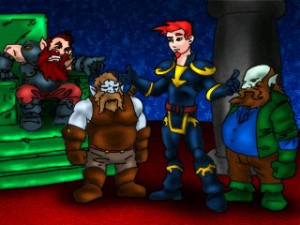Arvale: Journey of Illusion sold a bunch of copies on Windows Mobile, a bunch more copies on iPhone, and a disgusting amount of copies were bundled on a bunch of GPS devices. But that has nothing to do with this article. Arvale is a great game and it was successful for many factors. It’s still relatively successful today because it is still an enjoyable experience (unlike Nintendo’s Smurfs game for Atari 2600). A large part of that is due to Duncan and his story.
 Here is a brief explanation of why Duncan’s character worked so well: He’s a gardener, and kind of an idiot. Which makes him unfamiliar with the rest of the world. So when forced into a position where he is a Hero who is supposed to go on a Journey to save the world, he is completely unaware of what he is supposed to do, just like the Player who is playing the game. So the Player and Duncan have to figure out what to do together.
Here is a brief explanation of why Duncan’s character worked so well: He’s a gardener, and kind of an idiot. Which makes him unfamiliar with the rest of the world. So when forced into a position where he is a Hero who is supposed to go on a Journey to save the world, he is completely unaware of what he is supposed to do, just like the Player who is playing the game. So the Player and Duncan have to figure out what to do together.
 Guybrush Threepwood from Monkey Island 1 worked much in the same way, but without all the exposition and backstory needed in an RPG. Basically, Guybrush arrives on some unknown island (I think he washed up there?) and announces, ‘I wanna be a pirate!‘* ‘How do I do that?’ and that’s it. The player doesn’t need to know why he wants to be a pirate, he just knows that Guybrush wants to become one, and they both have to figure out how.
Guybrush Threepwood from Monkey Island 1 worked much in the same way, but without all the exposition and backstory needed in an RPG. Basically, Guybrush arrives on some unknown island (I think he washed up there?) and announces, ‘I wanna be a pirate!‘* ‘How do I do that?’ and that’s it. The player doesn’t need to know why he wants to be a pirate, he just knows that Guybrush wants to become one, and they both have to figure out how.
(And in both situations, the main character is forced into unfamiliar territories (Outside the Castle/Melee Island), so you don’t have to answer Player questions like: ‘Why doesn’t my character know where the toilet in his own house is?’)
These types of parallels in Game Design are not uncommon at all. When a bunch of things in the same field become common (usually from stealing borrowing inspiration), some expert will make up a term to tell everyone else what they already know. Like Game Design.
In fact, this type of thing is so common in story telling, that it’s not even called stealing anymore, a scholar sat around (Joseph Cambpell) and dubbed it the monomyth. Also known as the Hero’s Journey. He even wrote a really boring book called the The Hero with a Thousand Faces. I already read it for you, so don’t bother.
 While the book looks short in comparison with a 1000 page Stephen King novel; it takes longer to read than the entire Lord of the Rings books, twice, and then watch the un-cut director’s edition of the movies. It’s boring and overly verbose. We should pay senators to read this kind of stuff. And it ruined my vacation in Croatia… but that’s another story.
While the book looks short in comparison with a 1000 page Stephen King novel; it takes longer to read than the entire Lord of the Rings books, twice, and then watch the un-cut director’s edition of the movies. It’s boring and overly verbose. We should pay senators to read this kind of stuff. And it ruined my vacation in Croatia… but that’s another story.
The point is that the Hero’s Journey is something most good stories follow, not because of a road-map was laid out for them, but because that’s the pattern that emerged after studying hundreds of *good* myths and stories. Just like music theory or language grammar. Both are great examples, but I’ll do grammar this time.
Language grammar rules are created after the fact to try and explain how it works (which is why there are so many damn exceptions to the ‘rules’). You can’t learn a language by studying grammar rules and exceptions (kids don’t), but you can appreciate a languages grammar rules after you have learned it. If you apply those rules before learning the language, you’ll just suck and get confused all the time (highschool and university french/spanish/german students can feel me here).
Where am I going with this? Hollywood, of course! When you can’t be bothered to write good stories, just follow the monomyth and you will get a great story, right? Ah, but you can’t bother to read that boring book I mentioned, I know. Just get a Cliffs Notes version of it, like this diagram here. Then you can follow it literally and everything will be awesome!
Like at step, uh, 4: Crossing the Threshold (also called Belly of the Beast)- Upon reaching the threshold of adventure, the hero must undergo some sort of ordeal in order to pass from the everyday world into the world of adventure. This trial may be as painless as entering a dark cave (*cough* Star Wars) or as violent as being swallowed up by a whale (Pinocchio).
Not to say I don’t love Star Wars, I do. Lucas used the Hero’s Journey sparingly and it only sticks out to people like me who are familiar with the formula.
 But the entirety of Pirates of the Caribbean 2 through 3** was just too literal for me. You can precisely plot each node of the journey on the diagram I randomly found above without much thought. I mean, literally having Jack eaten by the Kraken? (I’ll forgive Pinocchio, it’s really old, Italian and involves a stupid puppet). It’s not a coincidence that no one else digs those two as much as the first one.
But the entirety of Pirates of the Caribbean 2 through 3** was just too literal for me. You can precisely plot each node of the journey on the diagram I randomly found above without much thought. I mean, literally having Jack eaten by the Kraken? (I’ll forgive Pinocchio, it’s really old, Italian and involves a stupid puppet). It’s not a coincidence that no one else digs those two as much as the first one.
All of the above can be applied to videogames. I didn’t even know what the Hero’s Journey was when I wrote Arvale 1. I don’t think I can even find the threshold, or crossing thereof, if I tried. But I’m sure a scholar could.
So stick to what you know, and just write a story that is interesting. Class dismissed. 🙂
